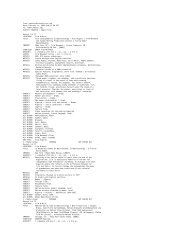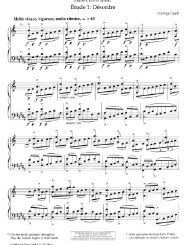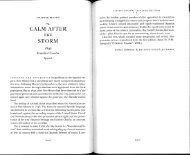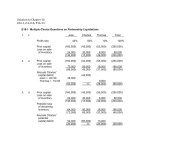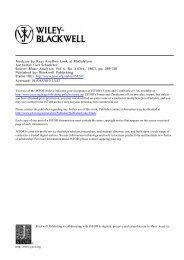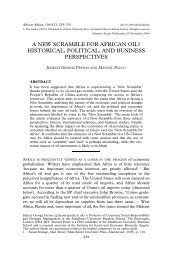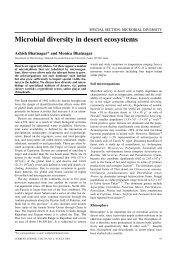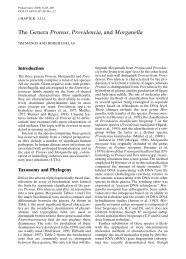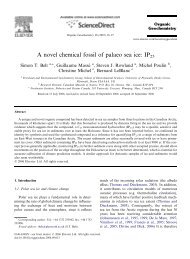The Genus Serratia
The Genus Serratia
The Genus Serratia
Create successful ePaper yourself
Turn your PDF publications into a flip-book with our unique Google optimized e-Paper software.
220 F. Grimont and P.A.D. Grimont CHAPTER 3.3.11<br />
Neumann 1896; excluded from the genus <strong>Serratia</strong> (Ewing et<br />
al., 1959); “atypical” S. marcescens (Colwell and Mandel,<br />
1965); “S. marcescens var. kiliensis” according to Martinec<br />
and Kocur (1961d) (not Ewing et al., 1962); <strong>Serratia</strong> III (Mandel<br />
and Rownd, 1964); <strong>Serratia</strong> pattern 2 (Fulton et al., 1959);<br />
atypical S. rubidaea (Ewing et al., 1972, 1973); and phenon<br />
C2 (Grimont et al., 1977b). <strong>The</strong> type strain is Grimont 510,<br />
CCM 640, and ATCC 183. <strong>The</strong> type strains of “Bacterium<br />
kiliense” reference is not an exact matchLehmann and<br />
Neumann 1986 and “<strong>Serratia</strong> esseyana” Combe 1933 are S.<br />
plymuthica.<br />
6. <strong>Serratia</strong> rubidaeaStapp 1940 (Ewing et al., 1973): “Bacterium<br />
rubidaeum” Stapp 1940; “Prodigiosus” VIII (Hefferan<br />
1904); S. marinorubra ZoBell and Upham 1944; <strong>Serratia</strong><br />
biotype 2 (Bascomb et al., 1971); phenon B (Grimont and<br />
Dulong de Rosnay, 1972; Grimont et al., 1977b); S. rubidaea<br />
DNA hybridization group (Steigerwalt et al., 1976). <strong>The</strong><br />
name appeared in the Approved Lists of Bacterial Names<br />
(Skerman et al., 1980). <strong>The</strong> type strain (neotype) is ATCC<br />
27593, CDC 2199–72, and Grimont 864. <strong>The</strong> former type<br />
strain (holotype) of S. marinorubra was NCTC 10912, ATCC<br />
27614, and Grimont 288. However, the Approved Lists of<br />
Bacterial Names (Skerman et al., 1980) listed S. marinorubra<br />
with ATCC 27593 as the type strain. Thus, both names (S.<br />
rubidaea and S. marinorubra) were made objective synonyms<br />
and the name S. rubidaea has priority. Three subspecies can<br />
be delineated: S. rubidaea subsp. rubidaea S. rubidaea subsp.<br />
burdigalensis, and S. rubidaea subsp. colindalensis (Grimont<br />
et al., manuscript in preparation).<br />
7. <strong>Serratia</strong> odorifera Grimont et al. 1978a: Strains similar<br />
to the unclustered <strong>Serratia</strong> strain 38 (Grimont and Dulong<br />
de Rosnay, 1972; Grimont et al., 1977b). <strong>The</strong> type strain is<br />
ATCC 33077, CDC 1979-77, Grimont 1073, ICPB 3995, and<br />
NCTC 11214. <strong>The</strong> name appeared in the Approved Lists of<br />
Bacterial Names (Skerman et al., 1980).<br />
8. <strong>Serratia</strong> ficaria Grimont et al. 1979c: the type strain is<br />
ATCC 33105, Grimont 4024, CIP 79.23, and ICPB 4050.<br />
9. <strong>Serratia</strong> entomophila Grimont et al. 1988: the type strain<br />
is ATCC 43705, Jackson A1, and CIP 102919.<br />
10. <strong>Serratia</strong> fonticola Gavini et al. 1979: Lysine-positive<br />
Citrobacter-like (Steigerwalt et al., 1976). <strong>The</strong> type strain is<br />
ATCC 29844, CUETM 77.165, Grimont 4011, and CIP 78.64.<br />
<strong>The</strong> name appeared in the Approved Lists of Bacterial Names<br />
(Skerman et al., 1980).<br />
<strong>The</strong> inclusion of the genus <strong>Serratia</strong> in the tribe Klebsielleae<br />
is no longer tenable. Studies on DNA relatedness, immunological<br />
cross-reaction between isofunctional enzymes, and<br />
the physical properties, regulation, and amino acid sequences<br />
of enzymes have all shown the genus <strong>Serratia</strong> to be consistently<br />
different from the group composed of the genera<br />
Escherichia, Shigella, Salmonella, Citrobacter, Klebsiella, and<br />
Enterobacter (reviewed by Grimont and Grimont, 1978a).<br />
Until the late 1950s, <strong>Serratia</strong> spp. were rarely isolated from<br />
human patients. Later on S. marcescens became more and<br />
more frequently involved in nosocomial infections and nonpigmented<br />
S. marcescens strains are now a serious threat<br />
in surgical and intensive care units (Daschner, 1980; von<br />
Graevenitz, 1980; Yu, 1979).<br />
Ecology<br />
For a long time, the confused status of <strong>Serratia</strong><br />
taxonomy prevented any precise knowledge of<br />
the habitat of <strong>Serratia</strong> species. After the aforementioned<br />
<strong>Serratia</strong> species had been defined,<br />
however, it became apparent that they occupied<br />
different habitats. Table 1 shows the distribution<br />
of the major species of the <strong>Serratia</strong> strains isolated<br />
from small mammals and their territories,<br />
and from water, plants, and hospitalized human<br />
patients. Table 2 shows the distribution of the<br />
major biotypes of the S. marcescens strains isolated<br />
from these same habitats.<br />
<strong>Serratia</strong> in Water and Soil<br />
Water is probably the principal habitat of S.<br />
plymuthica. Nomenspecies resembling S.<br />
plymuthica (Breunig’s Kiel bacillus, “Bacillus<br />
miniaceus,” “<strong>Serratia</strong> miquelii,” and “S. esseyana”)<br />
have also been isolated from water. Seawater<br />
isolates belong to the same species as<br />
terrestrial water isolates. “<strong>Serratia</strong> marinorubra”<br />
Table 1. Percent distribution among <strong>Serratia</strong> species of 1,543 strains isolated from different habitats.<br />
Species<br />
Small mammals a<br />
(92 isolates)<br />
a Rodents and shrews.<br />
b From plants and soil around the traps where small mammals were captured.<br />
c All plants except figs and coconuts.<br />
Animal territories b<br />
(51 isolates)<br />
Percentage of isolates in habitat<br />
Water<br />
(155 isolates)<br />
Plants c<br />
(137 isolates)<br />
Hospitalized patients<br />
(1,108 isolates)<br />
S. marcescens 10 2 75 10 97<br />
S. plymuthica 4 2 1 5 0<br />
S. liquefaciens 43 55 11 38 2<br />
S. proteamaculans 39 29 8 32 0<br />
S. grimesii 3 10 5 7 0.5<br />
S. rubidaea 0 0 0 1 0.2<br />
S. odorifera 0 0 0 4 0.1<br />
S. ficaria 0 2 0 4 0<br />
Total percentage 100 100 100 100 100



